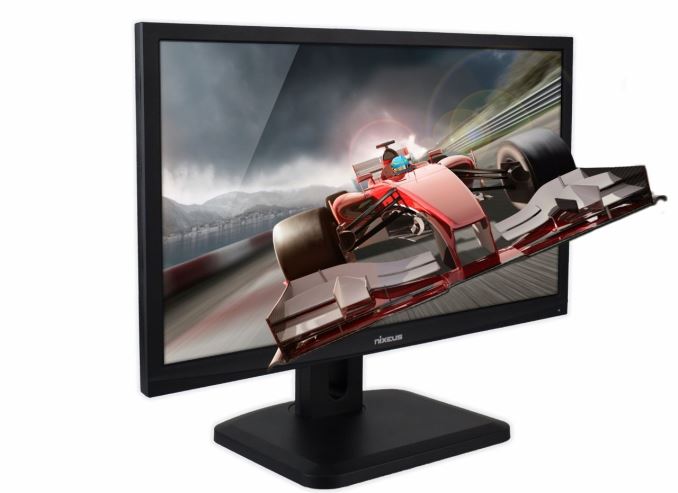Nixeus NX-VUE24A 144Hz FreeSync Monitor Set to Ship
by Ganesh T S on August 14, 2015 3:25 PM EST
We briefly covered the launch of the Nixeus NX-VUE24A FreeSync monitor as part of our write-up on AMD's FreeSync demonstrations at Computex 2015. Nixeus today sent news that the monitor is available for pre-order and set to ship as early as next week.
As a recap, the Nixeus NX-VUE24A is a 24" 1080p AMD FreeSync certified monitors with a minimum supported refresh rate of 30 Hz. The features of the NX-VUE24A include:
- 24" 1920 x 1080 TN panel
- Adaptive sync with refresh rates between 30 - 144 Hz
- 1ms response time
- DP 1.2a, HDMI, DL-DVI and VGA inputs
- Articulating stand for height adjustment (with tilt, pivot and swivel capabilities)
- 3-year warranty
AMD-certified FreeSync monitors come with a wide range of specifications and prices. Wikipedia has a list. Selected FreeSync models of relevance here (24" and 1080p resolution) include:
- The 24" 1920 x 1080 AOC G2460PF with a supposed refresh rate range of 30-160 Hz (availability outside Europe and pricing details are not known yet, and it appears that the maximum static refresh rate is only 144 Hz)
- The 24" 1920 x 1080 Samsung S24E370DL with a maximum refresh rate of 60 Hz (not yet available for sale in US, but a eBay listing puts a $400 price tag on it)
It appears that the Nixeus NX-VUE24A is the only 1920 x 1080 monitor currently available for purchase that comes with 30-144 Hz refresh rate support.
With a MSRP of $350 (and street price of around $330), the monitor seems to be priced right compared to other FreeSync monitors with similar feature sets. Pre-orders are being accepted at a number of e-tailers including Newegg, Amazon, and CouchPotato. CouchPotato seems to be offering free shipping and a new customer discount of 10%, while Newegg is charging $5 for shippping. Amazon seems to be selling at MSRP right now with free shipping.
Source: Nixeus










40 Comments
View All Comments
ExodusC - Friday, August 14, 2015 - link
Lost me at "TN panel."Is there some kind of inherent difficulty with implementing FreeSync on IPS panels?
Even the "good looking" TN panels don't look very good.
extide - Friday, August 14, 2015 - link
Nothing to do with FreeSync, it just that high refresh rate IPS screens are less common than TN ones,ganeshts - Friday, August 14, 2015 - link
Yes, and the target market (gamers) for this monitor demands TN panels due to a lot of other reasons (response time and refresh rates are much better, lower input lag - all the things that gamers want)nagi603 - Friday, August 14, 2015 - link
Actually, input lag on an IPS can also be low. Dell has some very good (and also very bad) monitors in this regard. It's got more to do with the actual electronics inside than the panel itself.Alexvrb - Friday, August 14, 2015 - link
First I'd like to point out that from what I've seen, the NX-VUE24B model has an MSRP of $20 less than the 'A' model and seems to only differ by having a standard stand. Now, can you point out an IPS Adaptive Sync display with >100hz refresh, 1ms response time and low input lag... in this price range? That would be fantastic.Mondozai - Saturday, August 15, 2015 - link
"Actually, input lag on an IPS can also be low"Yes, you're right. But "low" is a relative term. For serious gamers, the input lag is still too high.
Also, when you're gaming, IPS colors mean less than sheer speed, especially on some of the newer TN panels which actually have had decent color quality for a while now.
Unrelated: Bring us OLEDs!
surt - Saturday, August 15, 2015 - link
Can't give you Oleds. At 240hz, better color, 8k+ res, you'd never need to buy another display, and people might go out of business.tuxRoller - Saturday, August 15, 2015 - link
The very best gamers can't purposely respond to stimuli faster than about 100ms.Serious gamers remind me a bit of audiophiles.
CommandoCATS - Sunday, August 16, 2015 - link
It may very well be true that people cannot respond directly to stimuli faster than 100ms, but have a drummer try to play an electronic set through a computer that has >100ms, and absolutely there will be a difference. The latency through the whole system has to be much much faster than the minimum stimuli time.CommandoCATS - Sunday, August 16, 2015 - link
Also, 100 ms minimum means you're cool with running your games at 10 fps then.